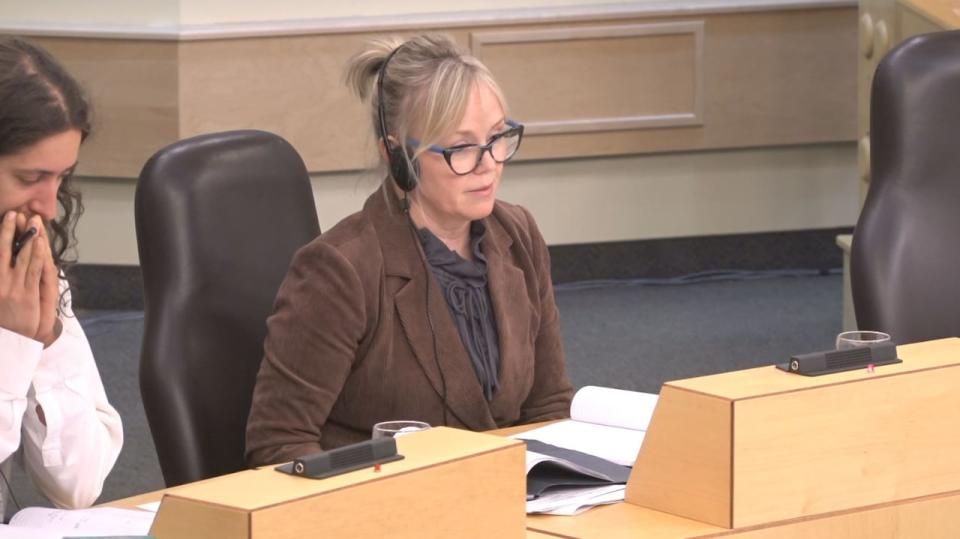


The working group that deals with remediating contaminated sites in Nunavut does not have an Inuk representative.
That statement was made during this week’s televised hearings of the Legislative Assembly’s standing committee on oversight of government operations and public accounts.
“That’s not to say there’s any restriction or opposition to having Inuit on the working group,” said Michele Leblanc-Havard, the director of environmental protection with the Nunavut government. “It’s just been the unfortunate situation that the representation from the department has not been Inuit in nature.”
Leblanc-Havard’s revelation came from a question posed by Iqaluit-Sinaa MLA Janet Brewster on Thursday on how Inuit are participating in and informing the working group.


Janet Pitsiulaaq Brewster is the MLA for Iqaluit-Sinaa. She brought up multiple concerns regarding contaminated sites in Nunavut. (Matisse Harvery/Radio-Canada)
Brewster mentioned there was another working group many years ago made up of officials from Inuit organizations to the federal and territorial governments.
“I wonder if there’s still a working group of people that are brought together to discuss the environment and food and animals related to the environment?” Brewster asked.
Leblanc-Havard said they do work closely with the Northern Contaminants Program, who said they’re concerned with contamination coming from Nunavut and how it impacts wildlife.
But Brewster pointed out a problem with the lack of Inuit representation in the working group.


Michele Leblanc-Havard is the director of environmental protection with the government of Nunavut. She says despite there being no Inuk representative, the working group that deals with contaminated sites in Nunavut is open to including one. (Nunavut Legislative Assembly)
“There isn’t a representative that seems to be there with specific knowledge about Inuit Qaujimajatuqangit,” she said. “I think it’s really important to have that representation; that voice; that knowledge on that working group.
“I wonder if there can be any thought put into expanding that working group to ensure that there is that knowledge, skills and very important abilities to give input into how the government of Nunavut approaches contaminated sites with its partners?”
Leblanc-Havard said it’s not lost on the Department of Environment and they will “work towards having better representation with respect to IQ and Inuit traditional knowledge.”
Relationship with the federal government
As outlined in the Nunavut government’s contaminated sites policy, the Department of Finance is the government’s primary point with the office of the Auditor General of Canada.
When asked how often the two parties met, deputy finance minister Dan Young said they never met specifically about this issue, but that it has come up in other meetings two or three times.


Dan Young is the deputy minister of finance of the Government of Nunavut. He says his department has never met with the Office of the Auditor General of Canada specifically about contaminated sites, but they have discussed it in other meetings. (Angela Hill/CBC News)
According to Nunavut’s devolution agreement with Canada, there are 148 sites that need remediation. Currently, the sites are the responsibility of the federal government, but as part of the agreement, they will be transferred to the government of Nunavut once they are remediated.
While Environmental Liabilities project manager James Elliott said he was unaware of what the cost is to remediate all 148 sites, it will be the federal government footing the bill.


James Elliott is the environmental liabilities project manager with the Government of Nunavut. He says the federal government will be paying for the remediation of the 148 contaminated sites in Nunavut that must be cleaned, according to the territory’s devolution agreement with Ottawa. (Nunavut Legislative Assembly)
He also admitted that it’s unlikely the federal government will remediate all 148 sites prior to devolution.
“But I believe once the transfer date occurs, those sites remain the Government of Canada’s until they are remediated,” Elliott said.
Despite Elliott’s assurances that Ottawa is still responsible for remediation, Brewster said she’s still concerned about the timeline.
“Are we talking 99 years? Are we talking five years?” she wondered. “It’s important to those impacted communities that these sites are cleaned up as quickly as possible.”
Elliott said although the Department of Environment consults with the signatory parties of the devolution agreement, they’re the ones with more information.
Database of other contaminated sites coming
A Nunavut government database of contaminated sites is set to be launched, but this will only contain sites that are the responsibility of either Nunavut municipalities or the territorial government.
Brewster said she wants to see a consolidated list.
“Communities know where contaminated sites are and don’t necessarily differentiate between whose responsibility it is to take action on remediating those sites,” she said. “I think it’s really important as a transparency issue as well as a really valuable tool for community members to come back to the government of Nunavut and indicate any new or ignored sites.”